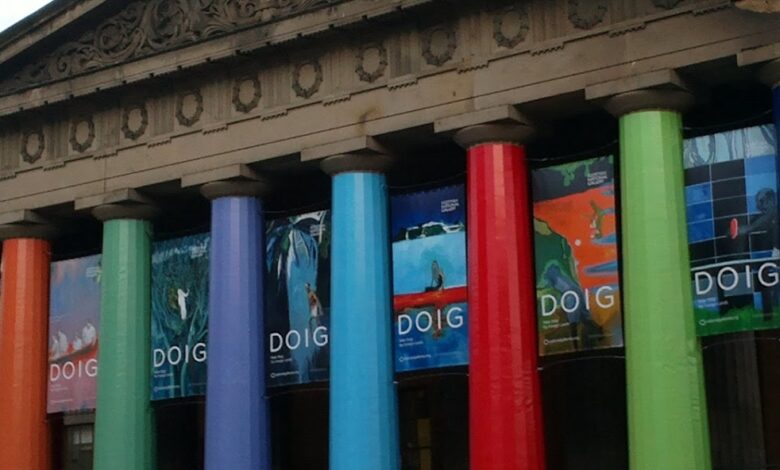Reflections of Now: Doig and Eisenman in Contemporary Art

Contemporary artists are reinterpreting the fundamental ideas of surrealism for the current world, even as modern surrealists—particularly women artists—are becoming more and more well-known.
The fanciful locations, unintelligible narratives, and surrealistic aspects of early surrealism continue to captivate viewers, but contemporary surrealist artists are adding fresh perspectives to the movement’s legacy. In their art, they employ surrealism methods to produce political, societal, and personal criticism.
Following World War I, the surrealism movement initially appeared in 1924. The movement was started by French author André Breton, who wrote the Surrealist Manifesto. It was inspired by the war’s devastation. By experimenting with illogical and magical components, artists aimed to combine reality and dreams and develop a new creative language.
Some of the most well-known figures from the surrealist movement include Salvador Dalí, René Magritte, and Max Ernst. Their creations pushed the limits of imagination while drawing on Freudian psychoanalysis. Within the movement, both abstract and figurative approaches have surfaced.
French-born American artist, Nicole Eisenman, is combining surrealist techniques with political commentary. Her grotesque figures bring out the absurdity in everyday life while also tackling societal norms, gender issues, and identity. Awarded the Guggenheim Fellowship and the Carnegie Prize, Eisenman acknowledges the influence of earlier female surrealists like Carrington and Tanning on her works. Their explorations of the female experience reverberate within her artwork.
Ewa Juszkiewicz, similar to Nicole Eisenman, questions identity through her portraiture technique. She employs historical portraiture, but obscures her female protagonist’s face with organic forms, challenging the traditional representation of women. Mexican Surrealist artist Frida Kahlo (1907-1954) is a leading art historical figure who has explored femininity and identity through surrealism in her time is a main inspiration in Juszkiewicz’s work.
In contrast, Peter Doig paintings channel surrealism through a sense of mystery and nostalgia. His enigmatic landscapes and haunting scenery bring about feeling of isolation and longing. Doig’s dreamlike works intertwine the nostalgic with the surreal to invite viewers to explore their own emotions and memories.
Nicholas Party is another contemporary surrealist artist with a distinct style. Party’s works carry surrealisms dreamlike quality while his polished and vibrant landscapes and portraiture create a striking contrast. His aesthetic is controlled and stylized. Meanwhile, Together, these artists highlight the diverse and evolving nature of surrealism, each contributing their unique voices to the dialogue.
In conclusion, contemporary surrealist artists continue to push the boundaries of imagination. Drawing from the movement’s rich history, their psychologically charged works invite viewers to reflect on emotional, social and political concerns. Surrealism continues to evolve in response to the contemporary life and the boundless potential of the human imagination.
Despite exploring diverse subjects and methods, both Nicole Eisenman and Peter Doig are extremely prominent modern artists whose work resonates via their distinctive fusion of abstraction and figuration. Doig is renowned for creating ethereal, dreamy settings that combine fantasy and recollection, frequently arousing feelings of mystery and melancholy. Eisenman’s art, which has its roots in both painting and sculpture, is more socially and politically charged and uses a combination of comedy and critique to explore questions of gender, identity, and queerness. Both artists question established artistic traditions, which makes them pertinent to current discussions in the art world.
Peter Doig and Nicole Eisenman push the boundaries of painting by expanding its narrative and formal possibilities in distinct ways. Doig reinvigorates landscape painting, incorporating elements of photography, cinema, and personal memory to create layered, surreal environments that challenge conventional perceptions of space and time. His work blurs the line between reality and imagination, inviting viewers into a meditative, often ambiguous visual experience.
Eisenman’s vivid, expressive work, however, defies conventional figuration by fusing historical allusions, grotesque characters, and comical elements. Her art blends comedy with a profound sense of humanity, challenging social standards and addressing current challenges. Together, they show how painting may continue to develop as a medium while simultaneously being both socially involved and contemplative.
Through their avant-garde methods that capture a nuanced interaction between individual story, cultural criticism, and enlarged notions of representation, Peter Doig and Nicole Eisenman exemplify the condition of contemporary art today. Doig’s ethereal landscapes arouse feelings of reflection and desire, striking a chord with current issues around memory and perception in a society growing more computerized by the day. His works reflects the trend in visual art toward emotional depth and subjective experience.
Eisenman, on the other hand, reflects the urgent social challenges of our day in his daring and frequently provocative works that question established norms surrounding identity, gender, and sexuality. Their different but complimentary approaches are representative of the field’s development and current significance because they demonstrate the diversity and inclusion that define contemporary art, where a variety of voices and viewpoints come together to address both individual and collective experiences.
The paintings of Peter Doig and Nicole Eisenman are significant because they provide important emotional and sociological reflections of our current environment. Doig’s vivid landscapes take viewers to places where imagination and memory converge, inspiring us to reflect on our own relationships to the environment and our own experiences. His ability to evoke nostalgia in the environment pushes us to examine the depths of our own perspectives. Eisenman, on the other hand, challenges us to face and examine the narratives we frequently take for granted through his colorful and frequently aggressive works, which demand interaction with the complexity of identity and society.
Collectively, their work not only enhances the visual discourse of our day but also invites us to consider our histories, identities, and cultural environments. Their contributions are not only pertinent but also crucial as they allow us to take part in the larger discussions influencing modern society.
Photo Credit: “Scottish National Gallery, Academy Entrance – Doig Exhibition” by Brian McNeil.




